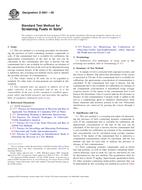Potrebujeme váš súhlas na využitie jednotlivých dát, aby sa vám okrem iného mohli ukazovať informácie týkajúce sa vašich záujmov. Súhlas udelíte kliknutím na tlačidlo „OK“.
ASTM D5831-09
Standard Test Method for Screening Fuels in Soils
Automaticky preložený názov:
Štandardná skúšobná metóda pre skríning Palivá v pôdach
NORMA vydaná dňa 1.7.2009
Informácie o norme:
Označenie normy: ASTM D5831-09
Poznámka: NEPLATNÁ
Dátum vydania normy: 1.7.2009
Kód tovaru: NS-32722
Počet strán: 10
Približná hmotnosť: 30 g (0.07 libier)
Krajina: Americká technická norma
Kategória: Technické normy ASTM
Kategórie - podobné normy:
Anotácia textu normy ASTM D5831-09 :
Keywords:
absorbance, contamination, extraction, field screening, fuels, soils, Coal oil, Crude petroleum products, Diesel engine fuel oils, Motor oil, Screen analysis--soils, Soil sampling, Synthetic motor oil, Used motor oil, ICS Number Code 13.080.10 (Chemical characteristics of soil)
Doplňujúce informácie
| Significance and Use | ||||||||||||||||||||||||||||||||||||||||||||||||||||||||||||||||||||||||
|
This test method is a screening procedure for determining the presence of fuels containing aromatic compounds in soils. If the contaminant fuel is available for calibration, the approximate concentration of the fuel in the soil can be calculated. If the fuel type is known, but the contaminant fuel is not available for calibration, an estimate of the contaminant fuel concentration can be calculated using average response factors. If the nature of the contaminant fuel is unknown, a contaminant concentration cannot be calculated, and the test method can only be used only to indicate the presence or absence of fuel contamination. Fuels containing aromatic compounds, such as diesel fuel and gasoline, as well as other aromatic-containing hydrocarbon materials, such as crude oil, coal oil, and motor oil, can be determined by this test method. The quantitation limit for diesel fuel is about 75 mg/kg. Approximate quantitation limits for other aromatic-containing hydrocarbon materials that can be determined by this screening test method are given in Table 1. Quantitation limits for highly aliphatic materials, such as aviation gasoline and synthetic motor oil, are much higher than those for more aromatic materials, such as coal oil and diesel fuel. Note 1—The quantitation limits listed in Table 1 are approximate values because in this test method, the quantitation limit can be influenced by the particular fuel type and soil background levels. For information on how the values given in Table 1 were determined, see Appendix X1. Data generated during the development of this screening test method and other information pertaining to this test method can be found in the research reports. (1,2) When applying this test method to sites contaminated by diesel fuel, care should be taken in selecting the appropriate response factor from the list given in Table 2, with consideration given to whether or not the fuel contamination is fresh or has undergone weathering/or biodegradation processes. See Appendix X2. A factor to consider in using this test method is whether the contamination is a mixture of one or more fuel types. If this is the case, and a site-specific response factor (see Appendix X2, Section X2.3) cannot be determined, the response factors for the individual fuel types in the mixture should be used to estimate contaminant concentrations. Certain materials, such as asphalts and asphalt residuals and oils and pitch from trees and other vegetation, which respond as fuel when tested by the method giving high blank absorbance values, may interfere with use of this test method. See 8.1.2.1 and Note 3 for information on determining if the test method can be applied to a specific soil containing one or more of these types of materials. Extractable material, which scatters or absorbs light at 254 nm, is a potential interference for this screening test method. TABLE 1 Approximate Quantitation Limits for Various Fuel Types in Soils Based on 0.036 AU
TABLE 2 Reciprocal Absorptivities at 254 nm for a 1-cm Path Length Cell
|
||||||||||||||||||||||||||||||||||||||||||||||||||||||||||||||||||||||||
| 1. Scope | ||||||||||||||||||||||||||||||||||||||||||||||||||||||||||||||||||||||||
|
1.1 This test method is a screening procedure for determining the presence of fuels containing aromatic compounds in soils. If the contaminant fuel is available for calibration, the approximate concentration of the fuel in the soil can be calculated. If the contaminant fuel type is known, but the contaminant fuel is not available for calibration, an estimate of the concentration of the fuel in the soil can be determined using average response factors. If the nature of the contaminant fuel is unknown, this screening test method can be used to identify the possible presence of contamination. 1.2 The values stated in SI units are to be regarded as standard. No other units of measurement are included in this standard. 1.3 This standard does not purport to address all of the safety concerns, if any, associated with its use. It is the responsibility of the user of this standard to establish appropriate safety and health practices and determine the applicability of regulatory limitations prior to use. |
||||||||||||||||||||||||||||||||||||||||||||||||||||||||||||||||||||||||
| 2. Referenced Documents | ||||||||||||||||||||||||||||||||||||||||||||||||||||||||||||||||||||||||
|
||||||||||||||||||||||||||||||||||||||||||||||||||||||||||||||||||||||||




 Cookies
Cookies
